
In an isothermal straight duct flow, the 'eight-vortex' secondary flow of Prandtl's second kind as in Fig. 1(a) is generated as a footprint of turbulent coherent structures [1]. When the bottom wall of the horizontal square duct is heated from below, the buoyancy affects these turbulent structures and drastically changes the skin friction and heat transfer rate over the walls and the behavior of coherent vortices under a various strength of buoyancy force the corner has been revealed at low Reynolds numbers [2]. However, at a transitional Reynolds number, the buoyancy effect has not been investigated.
At very low Reynolds numbers, the mean diameter of turbulent vortices is the same order of the duct width, therefore, the duct geometry strongly affects the generation mechanism of the secondary flow. As the bulk Reynolds number decreases, the secondary flow pattern drastically changes and becomes 'four-vortex' patterns [3]. And, at lower Reynolds number, the streamwise-localized turbulent puffs appear as in circular pipe flow.
In this study, the buoyancy effect on the four-vortex secondary flow pattern and localized puffs are investigated using direct numerical simulations. It is revealed that one of the four-vortex secondary flow patterns as in Fig. 1(b) is selectively stabilized by a weak buoyancy effect, and the generation of puffs is suppressed. Furthermore, it is revealed that the secondary flow also depends on the thermal physical property, i.e. the Prandtl number.
[1] Pinelli, A. et al., Reynolds number dependence of mean flow structure in square duct turbulence, J. Fluid Mech. 644, 107-122, (2009)
[2] Sekimoto, A. et al., Turbulence- and buoyancy-driven secondary flow in a horizontal square duct heated from below, Phys. Fluids 23, 075103 (2011)
[3] Uhlmann, M. et al., Marginally turbulent flow in a square duct, J. Fluid Mech. 588, 153-162 (2007)
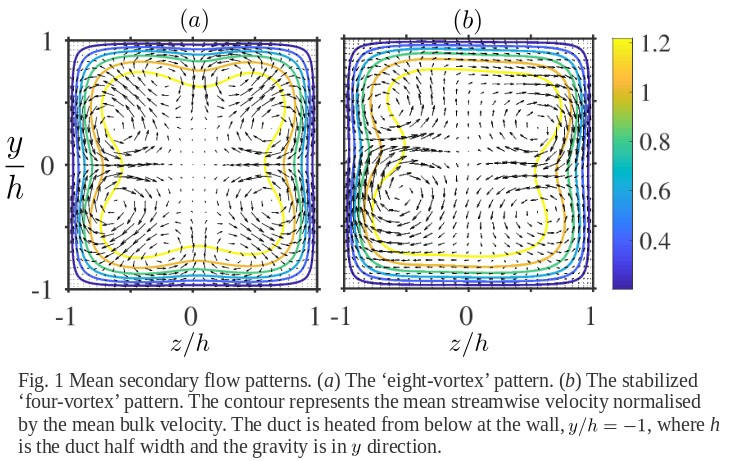
Heat transfer from a heated semi-circular cylinder placed in rectangular confinement has been investigated over wide ranges of the governing parameters as Reynolds number (1≤Re≤50), Prandtl number (0.7≤Pr≤50) and blockage ratio (0.2≤β≤0.8). The numerical solutions of the obtained governing equations for flow and heat transfer have been solved by considering, steady laminar flow in a channel. The combined influence of all governing parameters (Reynolds number, Prandtl number, and blockage ratio) on the flow and heat transfer characteristics have been delineated for the above ranges of the governing parameters. The streamline and isotherm profiles are obtained and used to represent the detailed flow and heat transfer characteristics. The gross engineering design parameters like recirculation length, drag coefficient, and Nusselt number are presented for scientific calculations and record. The distribution of pressure coefficient and local Nusselt number along the surface of the semi-circular cylinder are also presented to show the local variation in the quantities. The drag coefficient has shown an inverse relationship with the Reynolds number and positive dependencies on the blockage ratio, whereas the recirculation length has shown a reverse trend. Similar to drag coefficients, the Nusselt number shown positive dependencies on Reynolds number, Prandtl number and blockage ratio. Additionally, The functional dependence of recirculation length and average Nusselt number on Reynolds number, Prandtl number, and blockage ratio have been explored and the appropriate correlations to predict the intermediate values.
Keywords: Confined flow; Semi-circular cylinder; Nusselt number; Reynolds number; Blockage ratio; Prandtl number; Newtonian fluid
The flow and sedimentation characteristics of the microcapsules including phase change materials were investigated. As a phase change material, trimethylolethane (TME) clathrate hydrate which has the latent heat of 218kJ/kg was used at the concentration of 25 wt%. The mean diameter of microcapsules was 17 μm and the density of them with TME was 1.32kg/m-3 The concentration of silica hard shell microcapsules with TME was set at 10wt%. As drag reducing surfactants, oleylbishydroxyethylmethylammonium chloride was used with counter-ions of sodium salicylate whose molar ratio to the surfactant was fixed at 1.5. The concentration of surfactans was changed from 2.000 to 6,000 ppm. Polyvinyl alcohol (PVA) was also used as a stabilizer. The concentration of PVA was changed in two steps; 0 and 2000 ppm. Sedimentation experiments were performed in a test tube and the time variation of the apparent volume fraction of micorcapsule dispersion to the slurry was measured at 10 °C of temperature. The friction coefficients of the slurries treated with those additives were measured with a once-through flow system. The Reynolds number defined with water viscosity was changed from 200 to 25,000.
From the results, it was found that the microcapsules in the cases without additives and only with PVA settled to the bottom of the test tube immediately. On the other hand, the sedimentation delays in the cases with the combination additives of surfactants and PVA. The sedimentation was also found to occur slower with increase of surfactant concentration. From the measurements of the friction coefficients, it was found the friction coefficients show lower values in the larger region of 15,000 of Reynolds number. However, the friction coefficients increase with the surfactant concentration. Thus, the optimum condition was concluded to exist for the sedimentation and fluidity.
Acknowledgements: This study was supported by JST-Mirai-project:#JPMJMI17EK.
Since some Cu-based alloys, such as Cu–Co or Cu-Fe alloy, exhibit a metastable miscibility gap in the undercooled state, phase separation occurs when undercooling the alloys below their liquidus-line temperature. Such alloys are expected as new materials with novel properties depending on the phase separation structures. Although the phase separation structure is obviously affected by melt convection during undercooling, the correlation between the phase separation structure and the melt convection is not still clear.
The objective of this study is to elucidate the correlation between them in the Cu-Co alloy system. We utilized an electromagnetic levitator superimposed with a static magnetic field, which can control the strength of melt convection in an electromagnetically levitated molten alloy sample by the static magnetic field, to investigate the effect of melt convection on the phase separation structures of Cu-Co alloys. The sample diameter was 5 mm and the composition of alloys were Cu80CO20 and Cu58Co42. The strength of static magnetic field ranged from 0 to 5 T. Neutron computed tomography (CT) was used to visualize the three-dimensional phase separation structures. In addition, a series of direct numerical simulation (DNS) was also performed to calculate the three-dimensional velocity fields of melt convection in an electromagnetically levitated molten Cu-Co droplet under static magnetic fields, particularly magnetohydrodynamic (MHD) convection was focused on.
The neutron CT results showed that the phase separation structures depend on the static magnetic field strength. In particular, the marked difference in structure between 0.5 T and 3 T was observed, i.e., the size of Co-rich phases at 3.0 T is much larger than that at 0.5 T. The DNS results showed laminar-turbulent transition around 1 T. These results indicate that the marked change of phase separation structures has a strong relation with the laminar-turbulent transition.
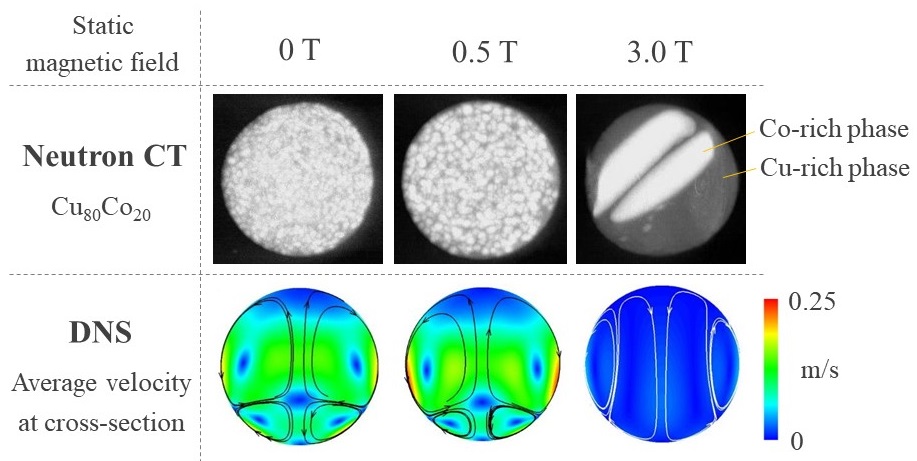
Containerless processing is an attractive synthesis technique as it permits deep undercooling in molten materials and the catalytic sites for heterogeneous nucleation are minimized. Thus, it provides a possibility to solidify the undercooled liquid into a selected phase to synthesize metastable materials with higher density and novel properties. It also offers a new approach to grow single crystal and forming new optical glasses using the containerless processing.
For oxide material, the containless processing is usually perfomed by aerodynamic levitation and electrostatic levitation methods. Electrostatic levitation furnace (ELF) is been operated in international space station (ISS) by Japan Aerospace Exploration Agency (JAXA) for thermophysical properties measuring of oxide melts in microgravity environment. Chinese academy of science (CAS) also is developing a new electrostatic levitation furnace for using in China space station (CNN).
In the recent years, we have successfully fabricated some fuctional oxide materails: the hexagonal BaTiO3 single crystal exhibited a dielectric constant value higher than 100,000 at room temperature; the new LaTi2O5 glass with a distorted five-coordinated TiO5 polyhedra glassy structure and a refractive index value higher than about 2.2. The thermophysical properties of density, viscosity and surface tension for high temperature melts up to 3,000 K have been measured using containerless levitation technology.
There is still a large demand for advanced combustion technologies for the stable production of power and electricity in our societies. Recently, numerical simulations have made outstanding achievements, and the number of research projects with Computational Fluid Dynamics remarkably increases with developing a computer performance. Under such situations, flamelet based tabulated chemistry has received much attention due to its high accuracy and relatively a low computational cost. In this work, using this approach based on a non-premixed flame, piloted methane/air jet flame was simulated by large eddy simulation. The numerical solutions showed good agreements to experimental data of temperature and major chemical species. Although the numerical solutions of temperature slightly overestimated the experimental data in the downstream, this difference was also reasonable because the effect of radiation was not included in the present simulation. Flame index, which is the indicator of local combustion mode, suggested the coexistence of premixed and non-premixed regions in the computational domain. Specifically, a premixed region was located in the inner side of the piloted jet while the combustion mode in the outer side of the piloted jet was non-premixed mode. To evaluate the influence of the flame type which is calculated prior to the main simulation, the look-up table based on premixed flame was constructed and used in an additional simulation. The detailed data obtained from the above simulations provided reliable insights for understanding the transport phenomena and chemical reactions of the chemical species in turbulent jet flames.
The combustion and heat release characteristics of hydrogen-methane/air (H2-CH4) diffusion flames on micro-jet array burner are focused in this research. The effects of H2-CH4 co-combustion and equivalence ratio on the flame structures, temperature, free radicals, heat release rate, and NO emission distributions of the H2-CH4/air diffusion flames are numerically investigated. The results show that the simulation results of OH distribution and flame length based on GRI 3.0 and Bilger mechanism are agreed well with the experimental results, showing an acceptable and repeatable results of H2-CH4 combustion based on those mechanisms. Furthermore, uniform and small flames can be formed at various H2-CH4 ratios. The intensity and distributions of heat release rate can be adjusted by H2-CH4 ratios and equivalence ratios. Finally, the dramatically enhancement of NO emissions at CH4 addition conditions are considered from the promotion of prompt NOx when CH4 added to the H2 flame.
An innovative multiphase AC arc (MPA) was drastically improved by diode rectification technique with bipolar electrodes. Temperature fields of the diode-rectified MPA (DRMPA) were successfully visualized on the basis of a high-speed camera with appropriate band-pass filters. The DRMPA had been developed to solve the electrode erosion issue, which was critical issue for MPA to be utilized in industrial fields. Diode-separation of AC electrode into a pair of cathode and anode led to drastic improvement of the electrode erosion characteristics. However, fundamental phenomena in the DRMPA are still poorly understood because of its novelty, although spatiotemporal characteristics of the arc and/or electrode temperature are necessary to develop the DRMPA for industrial applications. The purpose of the present study is to investigate temperature fluctuation characteristics of the DRMPA. Six phase AC arcs with and without diode-rectification were generated and their temperatures were measured by the high-speed camera system with appropriate band-pass filters on the basis of Boltzmann plot method. Figure shows electrode configurations and the two-dimensional temperature field of the DRMPA (a) and the conventional MPA (b)during one AC period of 60Hz. Results indicated that the arc temperatures of both DRMPA and MPA were fluctuated in the range from 7,000 to 13,000 K. The arc temperature near the electrode was higher than 10,000 K, while the temperature in the center region in the furnace was about 7,000 K. These obtained results suggest that the DRMPA is a promising heat source to fabricate attractive nanomaterials at a high productivity.
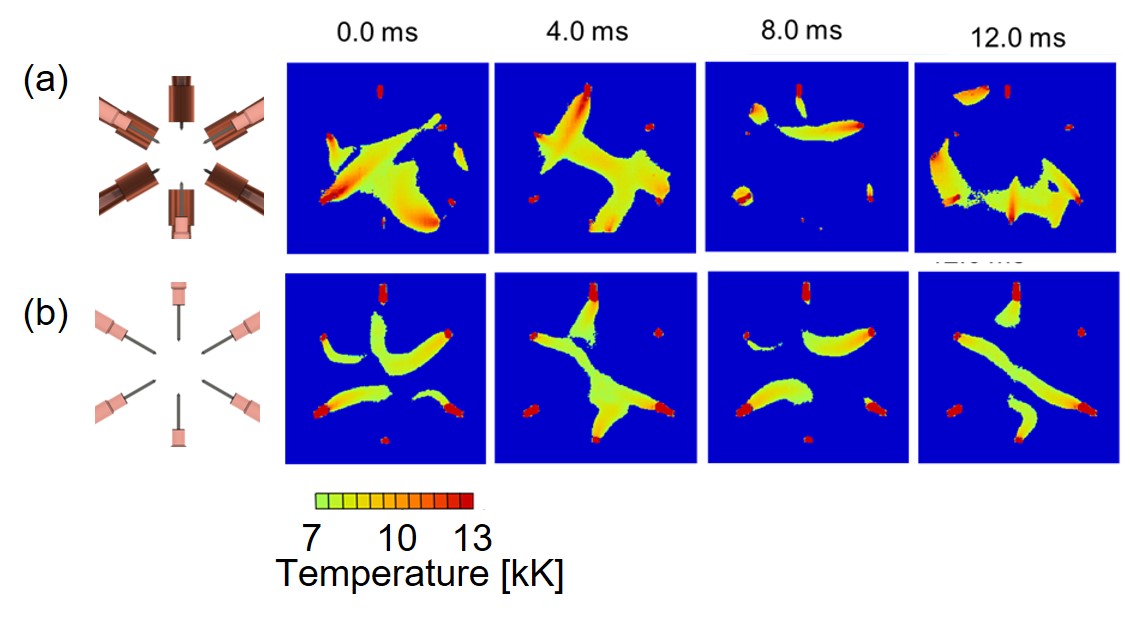
Thermochemical energy storage (TCES) has grown more attention in energy storage and conversion field, for its benefits in better reversibility, lower cost and safer chemical compounds, and higher energy releasing and storage density than conventional sensible and latent heat storage system among thermal energy storage systems. Calcium oxide/water/calcium hydroxide (CaO/H2O/Ca(OH)2) TCES system adapts for heat storage and releasing potential at 400 °C to 600 °C. Calcium carbonate (CaCO3) is used as a precursor for the TCES. However, the raw CaCO3 material from nature shows insufficient performance during heat storage capability and durability experiments. A composite material impregnated with silicon-related material of 0.6 wt% was developed and demonstrated superior reactivity and durability on repetitive operations than a conventional material studied previously. Instead of powder figure TCES materials, real reactors favor materials in pellet figure, then, the composite material in the pellet figure was developed and discussed kinetically TCES material performance in this study. The developed composite pellet material was evaluated by thermogravimetric analysis. The composite pellet was compared with a pure CaCO3 reference pellet on both hydration and dehydration processes. The heat output and storage density and their reaction rates of both materials were compared and discussed under the same operating condition. According to 6 cycles experiment, the composite pellet maintained stable reaction conversion and showed an increase of the hydration reaction rate. It was demonstrated that the additives for the composite had the positive effect and heat output density, Qh,m [kJ kg-material-1], of the composite pellet increased 32.7% in comparison with the pure pellet as shown in Fig. 1. Morphology change of samples before and after experiments indicated that the vapor diffusion and heat transfer were guaranteed by the additives which performed well as effective agglomeration prevention.
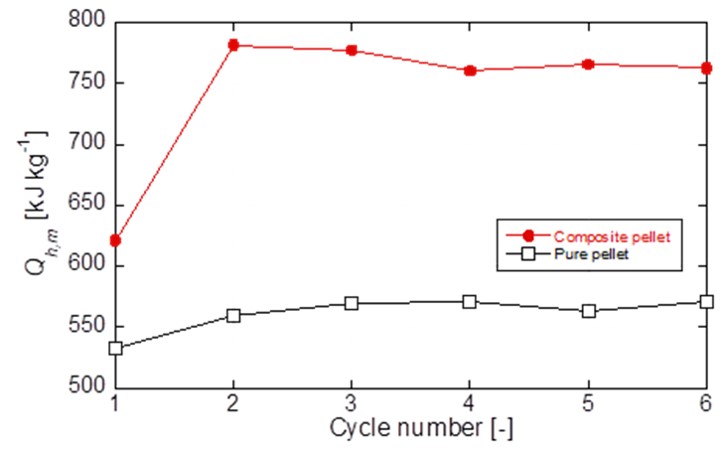
About 60% of the energy input in the chemical industry is discarded from the plant. Energy saving can be achieved in the entire plant by recovering these waste heats and reusing them as power and heat sources in the power plant. An adsorption heat pump has been developed for the purpose of regeneration of such unused energy.
In this study, saturated humid air was supplied to a device packed with 13X zeolite particles of 4 mm in diameter. The time variation of temperature in the apparatus was measured experimentally. Then, the maximum temperature was estimated from the relationship between heat balance and adsorption equilibrium. The trend of the maximum temperature calculated from the heat balance is consistent with experiment. Further, it was found from the result of the heat balance equation that the sensible heat of the moist air supplied and the heat of adsorption of the zeolite are mainly distributed to the sensible heat of the zeolite. In the future, it is important to make effective use of the sensible heat of this zeolite. In order to extract more thermal energy from the device, it is necessary to improve the heat transfer between the packed bed and medium.
A double pipe heat exchanger having a zeolite packed bed on the annular side was proposed as an apparatus. Flow direction of the humid air supplied to device was changed in two different ways. The one of them is supplying humid air vertically to the device and another is supplying the air in parallel. The influence of flow direction on heat transfer between packed bed and medium is studied with numerical simulation.
By inducing the inverse Marangoni convection, we successfully utilize a self-rewetting fluid to enhance the evaporative cooling of a spray system. The self-rewetting fluid is able to produce a surface-tension-driven fluid flow, which continuously replenishes the heated region to prevent dryout. As a result, cooling rate can be drastically increased. We find that the formation of a liquid film after the spray discharge is vital to this cooling enhancement, which requires a superhydrophilic surface and a proper spray height. Once the inverse Marangoni convection commences, the total heat transfer can be augmented three to seven times for a single pulse of spray. On the other hand, using the self-rewetting fluid in an intermittent spray system can be beneficial because comparable heat transfer rate can be delivered by spraying the self-rewetting fluid at much lower frequency. Although a longer spray pulse increases the heat transfer rate per cycle, the spray frequency also decreases for a given duty cycle which is unfavorable when a given time span is considered. Despite the moderate cooling rate per cycle for a shorter spray pulse, the time-averaged heat transfer rate is improved by the increase in spray frequency. For a fixed pulse duration, lower duty cycle leads to more sparse spray, higher surface temperature, and stronger inverse Marangoni convection. However, the resultant cooling rate is poorer and dry-out may occur if the duty cycle becomes too small. For large cooling-area application, we add more spray heads and find that deploying more nozzles helps to reduce the fluctuation in surface temperature but has little effect on the cooling rate. Increasing the spray frequency not only improve the cooling rate but also reduce temperature fluctuation. This enhancement becomes more apparent as the number of nozzles increases.
In recent years, printed electronics, in which wiring of electronic devices are formed by an inkjet method, has been focused. However, when a droplet is deposited on substrate by the inkjet method, there is a problem that it is difficult to control the width and the shape of the thin film. In our laboratory, it has been reported that the addition of surfactant to the coating solution causes Marangoni convection towards the center of the droplet at the surface due to the difference of surface tension, and the film becomes finer. However, the relationship between the flow in droplet and the shape of the film after drying droplet has not been clarified. Therefore, the purpose of this study is to clarify the effect of Marangoni convection on thin film shape by visualizing the flow inside droplet. Samples of the anisole-polystyrene solution with a surfactant are prepared. Each of them includes surfactant in various concentration and a small amount of fluorescent polymer as tracer. Surfactant in each solution is one of the four. Then a small amount of powder fluorescent polymer was added to each solution as tracer. Two experiments for prepared solutions were conducted, which are the dropping them on substrate and measurement of surface tension. Each solution was deposited on a hydrophilic substrate as a droplet with diameter of 80 micrometers using an inkjet method. Finally, the internal flow of droplet during evaporation and the shape of the thin film after drying were observed. Surface tension was measured for solutions including surfactant in various concentrations. As a result, it was revealed that the thin film after drying of a droplet became fine and ring shape tends to be suppressed by Marangoni convection. Additionally, the measurement of surface tension showed that the visualized flow is Marangoni convection.
This study focus on the synthesis of amorphous silicon nanoparticles by induction thermal plasma and understanding the formation mechanism. Crystalline Si powder with 5 μm of average diameter was injected into the induction thermal plasma at 20 kW-4MHz under atmospheric pressure. The powder feed rate ranges from 64 mg/min to 400 mg/min. Counter-flow quenching gas up to 70 L/min was axially injected from downstream of the torch to enhance the quenching effect for silicon nanoparticles. In the high temperature plasma region, the raw materials immediately evaporate. In the tail region of the plasma flame, supersaturated Si vapor starts to nucleate and then condenses onto its nucleus forming Si nanoparticles. The effect of the operating parameters such as quenching gas flow rate and powder feed rate have been investigated. The collected particles were characterized by using X-ray diffraction (XRD) and transmission electron microscopy. The amorphization degree was defined as the mass fraction of amorphous silicon in the silicon nanoparticles including both crystal and amorphous, and was calculated by internal standard method with XRD results. The obtained results show that higher quenching gas flow rate and lower feed rate lead to smaller diameter with higher amorphization degree. Figure 1 shows the diffraction patterns of nanoparticles with diameter which is equal to 140 nm and 8 nm, respectively. Smaller nanoparticles in Fig. 1 (b) are amorphous because of the appearance of the diffuse rings, while most small nanoparticles agglomerated together. For huge nanoparticle in Fig. 1 (a), some clear and regular diffraction spots are observed in the patterns, and means that the sample is crystal. This research indicates that induction thermal plasma can be used to synthesize pure amorphous material at a single step.
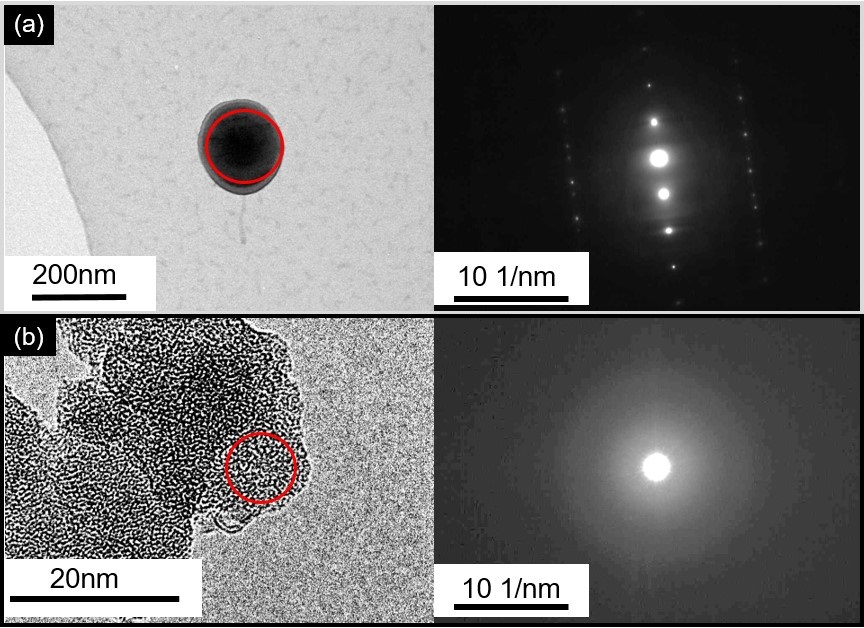
Oil and gas pipeline blockage due to gas hydrate formation in the deep ocean should be well managed because it would lead to environmental disasters and economic losses. To avoid this issue, researchers have been searching for effective hydrate inhibitors. Kinetic hydrate inhibitors (KHIs) are well-known substances to suppress gas hydrate formation with a small dosage (typically less than 1 wt%) whereas thermodynamic hydrate inhibitors (THIs) require a dosage up to 60 wt%. In this study, we examined inhibition performances of specific HBDs and HBAs using a high-pressure autoclave reactor and a high-pressure micro-differential scanning calorimeter (HP μ-DSC). We used a ramping method with a gradual decrease of temperature (0.2K/min) to measure onset points of hydrate formation which was detected by an abrupt pressure drop. The onset temperatures obtained by this method enabled us to estimate the performance of each inhibitor molecule as a KHI. Furthermore, we used COSMO-RS (COnductor like Screening MOdel for Real Solvents) program to see how the molecular structure and electron distributions of these HBDs and HBAs can affect CH4 hydrate inhibition. We obtained an electron density histogram named σ-profile and a characteristic function named σ-potential to visualize relationships between experimental results and screening results of each molecule. These results will demonstrate how HBD and HBA molecules affect CH4 hydrate inhibition with molecular interaction between inhibitor molecules and host water molecules and contribute to guiding us in the search of effective and environmentally benign inhibitors.
Incineration is one of the most general methods to treat industrial waste. Much amount of bottom ash is landfilled without being reused. Reduction of components such as harmful metals contained in bottom ash under appropriate incineration conditions makes it possible to reduce the amount of landfill waste and to increase the amount of reuse bottom ash. Management of conditions to control of bottom ash content has to be done for various kinds of industrial waste whose contents changes every day.
As the first step to improve incineration conditions, the effect of the primary air supplied to the bottom of a rotary stoker furnace is mainly investigated in this study.
Combustion characteristics of industry waste with typical component are numerically investigated using a combustion simulation program. It is confirmed that auxiliary fuel is necessary to burn the waste when preheated primary air is not supplied. On the other hand, preheated primary air enhances dry rate of input materials and enables to burn the waste without auxiliary fuel.
On practical process (commercial facility), components and calorific values of input material are commonly controlled by mixing some kinds of wastes. The preheated primary air effects on reduction of bottom ash amount, decrease of auxiliary fuel consumption and stabilization of furnace operation. The fluctuation ranges of the measured values such as temperatures in the facility are narrowed by preheated primary air, being independent of components of the input materials. This is mainly because the air enhances dry rate in the furnace. Consequently, preheated primary air is found to result in stable operation.
In order to develop a novel material for chemical heat pumps using hydration/dehydration of calcium chloride, the hydration equilibrium characteristics of calcium chloride encapsulated in silica hard-shell microcapsules has been investigated. The microcapsule with the mean diameter of about 20 micron has nano-size holes on their surfaces for hydration and dehydration reaction. In this study, the effect of the nano-hole size was focused on. The effects of the shell thickness on the equilibrium characteristics of calcium chloride were also discussed. The nano-hole size was changed from 147 to 1110 nm. The open ratio of hole area to the microcapsule surface increases with nano-hole size from 0.80 to 3.9 % in the present condition. The shell thickness was changed in two steps of 1.9 and 2.3 micron. The calcium chloride six hydration was inserted into the microcapsules. The equilibrium temperature of the dehydration was measured by a thermogravimetry at atmospheric pressure. The heating rate was set at 5 K/min.
From the results, it was found that the dehydration temperature of calcium chloride included in a microcapsule is slightly low. It was also found that the equilibrium temperature decreases with the nano-hole size decrease, in spite of the pressures loss increase for finer nano-hole cases. This indicates the equilibrium condition changes due to a capillary force by interface tension or osmosis effects in the nano-holes. In the case of thin shell, the dehydration temperature was found drastically to decrease. This might occur due to the above reasons under the condition of decrease of pressure loss effects. From the present results, it was concluded that the calcium chloride encapsulated in the microcapsules with fine nano-holes and with thin shell is a promising candidate for the high-performance chemical heat pump composites.
Al is widely used as a material for various heat exchangers because of its high thermal conductivity, small mass density, and high plasticity. The device performance has been improved by making the fins finer, however, it is difficult to make finer structure (< 1 mm). Carbon nanotubes (CNTs) also have high thermal conductivity and small mass density. In addition, simple fabrication of fine structure is possible via their self-organization process. Here we propose CNT-Al hybrid heat exchangers by growing micro-fins of CNTs directly on the conventional Al fins.
CNT arrays can be grown directly on Al sheets by chemical vapor deposition (CVD), however, their height remained 0.1 mm or less due to the low melting point of Al (660 °C). We realized 1.1 mm-tall CNT arrays by CVD at 600 °C [1]. To prevent the deactivation of catalyst pre-sputtered on Al, the C2H2 source was fed at low concentration with CO2 additive at high concentration. This method enabled tall CNT arrays but in a long CVD time (1.1 mm in 12 h). Then we elevated the C2H2 concentration and fed ferrocene (Fc) simultaneously, to grow CNTs fast and deposit Fe catalyst continuously. This method enabled >0.5 mm-tall CNT array in 2 h. Al sheet was prepatterned by using a pen-ink for selective catalyst deactivation (Fig. 1a) and the resulting CNT array was densified by wetting with ethanol and successive drying (Fig. 1b,c). Finally, we examined the heat dissipation performance using plate heater and N2 gas flow. Compared with the Al sheet, the performance improved about 1.5 times with the CNT fin arrays set parallel to the flow and about over twice set perpendicular to the flow (Fig. 1d). It is surprising to obtain such significant improvement. CNT fin structure induces vortex and make boundary layer thinner. Detailed analysis is underway.
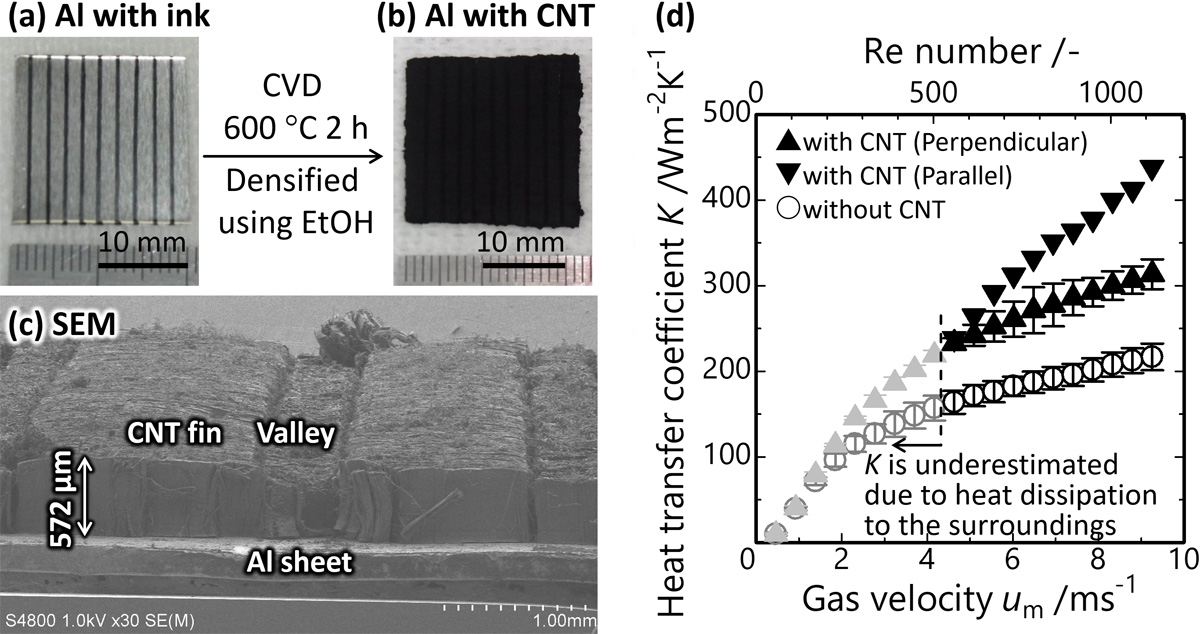
Nanoparticles in heated pipe flow are known to enhance the heat transfer ability of fluids. Although positive effects on the improvement of heat transfer ability of nanoparticles have been experimentally confirmed, it is difficult to identify the reason and mechanism of heat transfer with solely empirical way. Thus, we theoretically investigated the heat transfer mechanism of nanofluid containing graphene flakes (GFs), which exhibits good thermal conductivity, using coarse-grained molecular dynamics (CGMD). The size of 2.2 nm GF was used for nanofluids and four carbon atoms were replaced by one CG bead to maintain the hexagonal structure of GF. Heat transfer coefficient (HTC) of coolant, a mixture (50:50 wt%) of water and ethylene glycol (EG), containing GFs (1 wt%) was estimated in nanopipe flow system, of which the pipe is made of iron. Heat transfer trend was studied according to the functional groups (-H, -OH, -COOH) of GF. GF with hydrophilic functional groups (-OH, -COOH) showed higher dispersibility in the fluids than H-terminated GF. Also, nanofluid with COOH-terminated GF showed 25% higher thermal conductivity than that of without GF. In the nanopipe flow system with 0.1 â/ps of flow rate, we presented temperature, velocity, HTC profiles of nanofluids to elucidate the heat transfer mechanism. In the entrance region, GFs were located near the pipe wall and worked to transfer the heat of pipe to fluid. In the thermally fully developed region, GFs gradually moved to the center of pipe. Interestingly, the thermal boundary layer was maintained in the thermally fully developed region in the fluid. Additionally, GFs with hydrophilic functional groups showed larger HTC with higher rotation rate in the fluid.
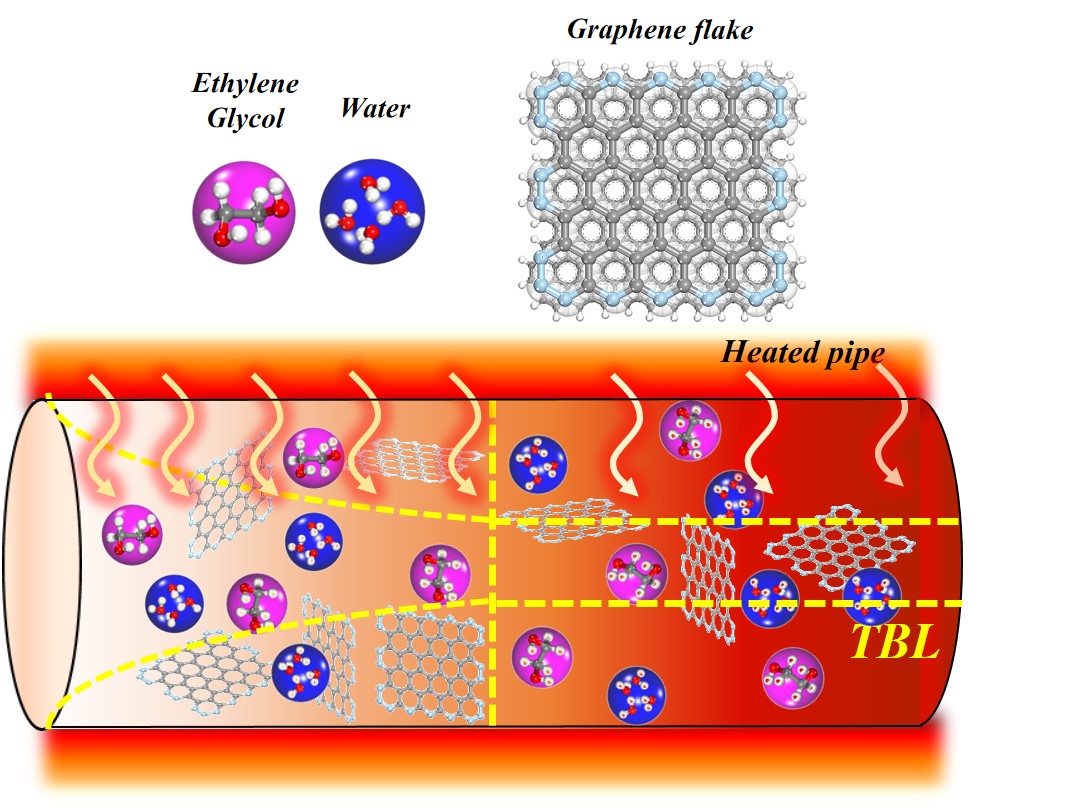
Copper nanowire (Cu NW) with high aspect ratio was obtained by D-glucose reduction under mild hydrothermal conditions. Use of oleylamine/oleic acid as Cu NW surface stabilizer led to obtain high aspect ratio over 1,000 of Cu NWs. Addition of small amount of sodium chloride for improvement of yields of Cu NWs up to over 90 % at optimum experimental condition. After centrifugal washing and recovery, direct surface modification of Cu NWs by immersing into hexane solution of fluoroalkylthiol self-assembled monolayer (SAM) were performed for achieving long lifetime well-dispersibility of Cu NWs into hydrofluorocarbon (HFE) -base heat transfer fluids. Applying the vacuum drying process of fluoroalkylthiol SAM functionalized Cu NWs in order to remove resume solvent such as deionized water and hexane surface led to obtaining highly dispersion stability over six months of fluoroalkylthiol SAM functionalized Cu NWs into HFE fluids.
The thermal conductivities of fluoroalkylthiol SAM functionalized Cu NWs dispersed HFC base nanofluid were measured by using transit thin hot wire (THW) method. A platinum thin wire coated with 3-mercaptopropyltrimethoxysilane (MPS) / tetraethoxysilane (TEOS) / 1H, H, 2H, 2H-perfluorodecyltriethoxysilane (PFDTS) hybrid film was used as a heating element and a resistance thermometer. High quality thermal conductivity measurement could be achieved by using thicker MPS/TEOS/PEDTS hybrid insulator coated platinum thin wire because of minimizing electrical leakage of fluoroalkylthiol SAM functionalized Cu NWs nanofluid in measurement cell. The effective thermal conductivities of obtained SAM functionalized Cu NWs dispersed nanofluids were increased as Cu NW concentration increases and maximum increase ratio was up to 80% comparing with the base HFC fluid.
Silicon carbide (SiC) is a promising wide-band gap semiconductor material for power devices due to its high electrical breakdown field and high thermal conductivity. But the performance of SiC devices is limited by the quality of the crystal growth because of the high dislocation density and high residual stress. In order to remedy these shortfalls, solution growth processes have been developed to grow high quality crystals. One of such solution growth processes is the Top Seeded Solution Growth (TSSG) method. However, it was found that in this growth process the Marangoni convection developing in the melt is strong and has an adverse effect on crystal homogeneity [1]. Therefore, we focus on the bottom seeded solution growth (BSSG) method shown in Fig. 1, since this technique had shown reduction in dislocation density in growth of GaAs [2]. In addition, the adverse effect of Marangoni convection is not significant because the seed is at the bottom of the crucible.
To the best of our knowledge, most numerical simulations in the literature were conducted in 2D. In this study, we carried out a 3D numerical simulation to investigate the transport phenomena occurring during the BSSG process of SiC. The simulation model includes the induced electromagnetic field, the radiative and conductive heat transfer in the furnace, and the mass transfer and fluid flow in the melt. The results showed that the Lorentz force in the 3D flow structures of melt is dominant while the contributions of buoyancy and Marangoni flows are small and the corresponding flow patterns remain axisymmetric. It was also found that the crucible rotation has a significant effect on growth rate. While the crucible rotation improves crystal uniformity, it decreases the average growth rate.
[1] T. Yamamoto et al., J. Cryst. Growth., 470 (2017), 75-88.
[2] K. Hoshikawa et al., J. Cryst. Growth., 94 (1989), 643-650.
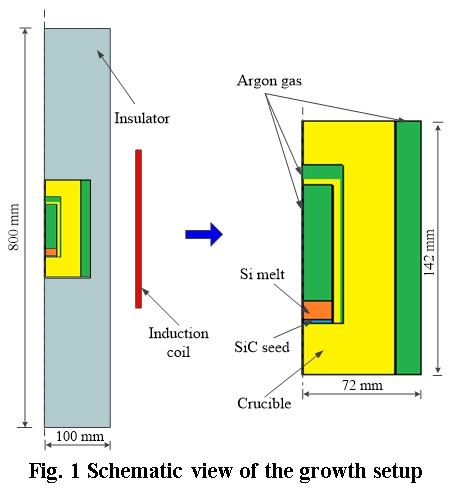
The direct numerical simulations of fully-developed turbulent plane channel flow with a spanwise narrow computational box to understand the turbulent heat transfer over the wall. We would like to demonstrate the effects of near-wall turbulent vortices on the heat transfer rate. The configuration is stably stratified channel flow with an imposed temperature difference between the top and bottom walls as shown in Fig. 1(a). The equations of continuity, Navier-Stokes and energy are discretized by using a high-fidelity spectral method and third-order Runge-Kutta semi-implicit scheme in the time integration [1].
In the present configuration, the spanwise narrow computational domain significantly reduces the computational cost and enables a parametric study of buoyancy effect on the instantaneous turbulent structures. In this study, the effect of the Richardson number which is the ratio of buoyancy force and inertial force are investigated at relatively high Reynolds number at the Prandtl number, Pr = 1. The obtained turbulent statistics are used to validate by comparing with the existing databases and the agreements and discrepancies due to the spanwise narrow computational domain are also discussed.
The vortical structures in the lower half of the channel flow are visualized as in Fig .1b using so-called Q criterion, i.e. the second invariant of the velocity gradient tensor. These turbulent vortices contribute strong turbulent intensity near the wall and turbulent heat transfer over the wall is enhanced. The effect of buoyancy on the turbulent statistics and the relationship between coherent vortices and the mean heat transfer rate will be discussed.
[1] J. Kim, P. Moin, and R. D. Moser. Turbulent statistics in fully developed channel flow at low Reynolds number. J. Fluid Mech., 177:133-166, 1987.
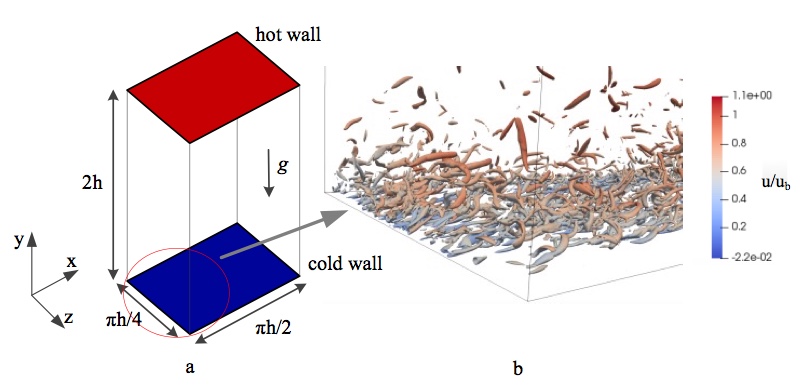
In a thin film evaporator (TFE), the axial distribution of liquid concentration is not clear, so it is difficult to predict the final concentration under various equipment design patterns and operating conditions. The focus of this research is on the evaporation of an acrylic polymer solution in TFE, a simulation model of which is proposed in this research.
In this model, the axial distribution of the concentration from top(inlet) to bottom(outlet) in TFE is simulated by sequentially calculating the shell balance of energy and mass. As outputs of this simulation, final concentration of the acrylic polymer is obtained. Parameters for correlating heat transfer coefficients and some factors are determined by least squares method using bench scale and plant scale equipment.
This simulation model is useful for predicting final concentration of polymer solution under unknown design patterns. For example, in case of changing blades number, there are several patterns (ex. position, number), and each of them have a different final concentration. By using this simulation, the several patterns of the final concentration can be calculated. As a result of changing blades number in plant scale, the measurements of the final concentration are within 2σ (95% confidence limit) of the predicted value, and it can be seen that both of them is in good agreement.
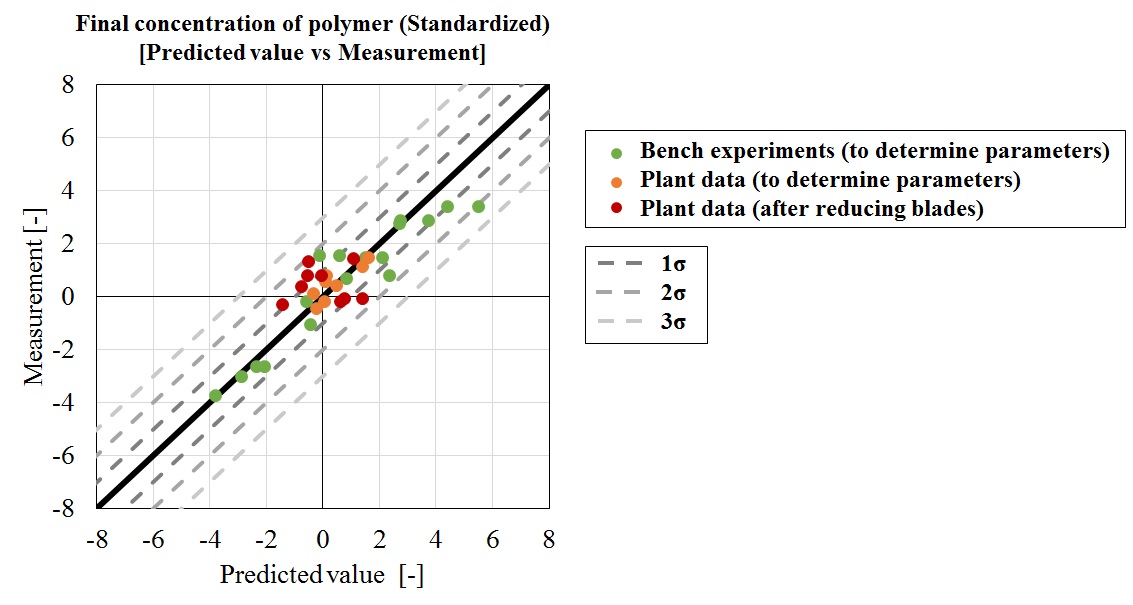
In general, a supramolecular gel is known to show reversible gel-sol transition responsive to various external stimuli such as heat and pH changes because of its weak non-covalent crosslinking. In this study, however, we designed a thermo-irreversible supramolecular gelator. The gelator was prepared by mixing a peptide lipid, NH2-C12-Gly-Gly-Gly-His (amino-C12G3H), and 4-ethylbenzaldehyde (EBAL) in an aqueous solution (pH 10.0). Mixing amino-C12G3H and EBAL forms an imine bond, which is a reversible reaction (Figure 1). We anticipated that the formation of an imine bond produced a supramolecular gelator to gelate an aqueous solution. Heating the resultant gel caused the gel-sol transition and evaporated the volatile aldehyde (EBAL). The removal of EBAL did not allow gelation upon cooling, which would achieve thermo-irreversible gel-sol transition in the supramolecular gel. In fact, the formation of a supramolecular gelator gave a supramolecular hydrogel and a microfibrous structure (self-assembly of the gelator molecules) was observed by TEM. After the supramolecular gel was heated at 80 °C for 40 min with keeping a cap of a sample vial open, the solution never turned to gel again (thermo-irreversible gel-sol transition). 1H-NMR measurements confirmed the removal of EBAL after heating. Finally, we tried to visibly record thermal hysteresis on a supramolecular gel. Tuning the EBAL concentration and heating time at 80 °C controlled the thermo-irreversible gel-sol transition, indicating that the present system can visualize and record the thermal hysteresis as gel or sol. The use of benzaldehyde as an aldehyde, which is more volatile than EBAL, allowed the thermo-irreversible gel-sol transition at 50 °C, meaning that the temperature for the thermo-irreversibility can be controlled by the selection of an aldehyde.
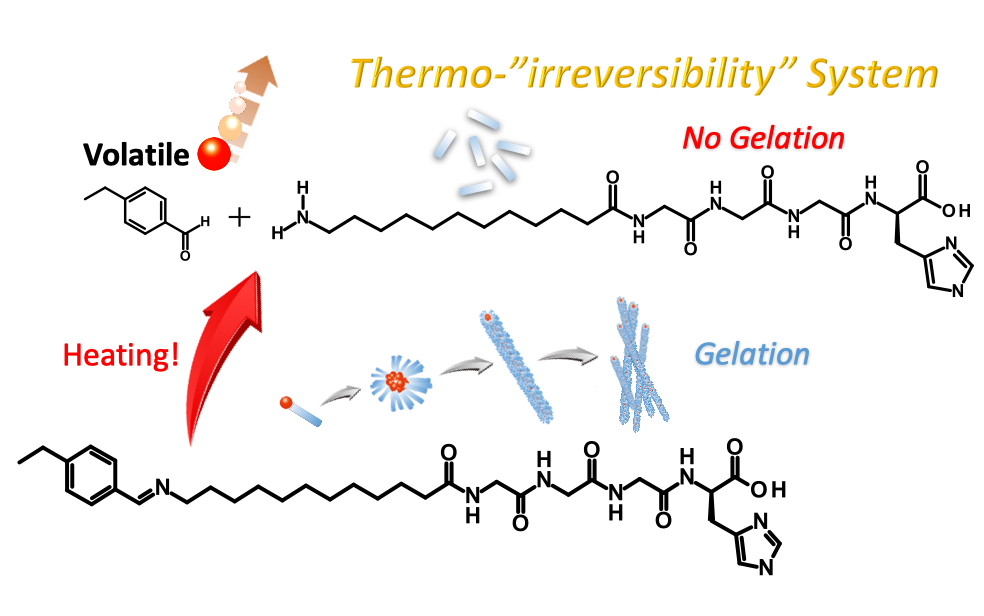
Power generation by variable renewable energy (VRE) is increased for decarbonization, which need suppress output to control the quality of electricity. As a power reserve, wind powered thermal energy system was proposed, which stores heat generated from rotating energy and produces steam to drive turbine or direct use. In this study, we examine Thermal Energy Storage system in Paper mill (TESP) and simulate to estimate capacity of thermal energy storage (TES) at paper mills all over Japan. Paper mills converts large amounts of energy by in-house boilers and turbines , the capacity utilization ratios (CUR) of which are fluctuated depending on the paper demand and fuel prices .
A concept of TESP is that heat from boilers and VRE is stored in TES and converted into steam or electricity like the system of concentrated solar power. Excess heat stored in TES generates constant electricity to sell to power grid. Constant generation of steam and electricity can reduce cost by raising CUR of energy plants, and decarbonize by accepting VRE .
We simulated energy balances with and without TES in a paper mills. Without TES, CUR of energy plants were low due to the fluctuation of energy demand. With TES, CUR were basically increased by storing excess heat. The necessitated capacity of TES varies by operation patterns. When production lines stop all together, large capacity of TES is required since large amounts of excess heat is generated. Through this simulation, we can estimate capacity of TES depending on paper demand all over Japan.
We conducted a simulation to design appropriate specification of TES depending on paper milling process and operation. This simulation will facilitate the design of appropriate scale of TESP depending on paper demand, cost and environmental impacts. Paper mills may be a supplier of heat and electricity from distributed energy sources.
Some processes such as flotation with nano or micro bubbles, mechanical operation like centrifuge separations and electro conglutination have been used for the demulsification of the wastewater produced from the well. Recently, demulsification by mean of usage of quick thermal response of microwave heating has been proposed as an efficient method. Our previous study found special microwave behaviors for interfacial tension between two liquids [1]. For example, there is hysteresis of interfacial tension between heating and cooling process and the tension after the irradiation does not return to the original value. Moreover, difference between thermal effect and non-thermal effect like non-equilibrium local heating, which is caused by the vibration of water molecule around the interface, is not clear. In this study, interfacial tension between decane-water was measured during and after microwave irradiation when concentration of NaCl in water was changed to investigate effect of saline solution on the microwave special behavior. First, hysteresis was observed between the heating and cooling interfacial tension as well. The above special behavior such interfacial tension reduction was confirmed and the effect was prompted by addition of salt in water phase. This is because microwave absorbs in water phase with salt more strongly. As a result, more emulsions are produced around the interface, and they interrupt tension along the interface. Recently, the efficient separation process of emulsion water produced at mining crude oil has been required. Finally, this technique has a potential as higher performance of the separation process by interface modification.
Thermal analysis of packed bed with two particles, which show different emissivities and thermal conductivities, was conducted by homogenization method. Sigmoidal curve as a function of Nusselt number with a thermal radiation coefficient was obtained. The emissivities are enclosed in the Nusselt number, and parameters representing shape of sigmoidal curve are mainly decided by ratio of the particle number and the thermal conductivities of two particles. Finally, it was found that thermal radiation analysis in more complex structures like packed bed and porous medium became simpler by homogenization method, and this multi-scale simulation is expected to contribute reduction of computational cost.
Fluctuation phenomena of plasma jet flow in an innovative long DC arc system with ring-shaped anode were successfully clarified on the basis of the high-speed camera visualization. The long DC arc with long electrode gap distance more than 350 mm has been applied to gas decomposition due to its advantages of long plasma length, resulting in long residence time of treated gas. However, large heat loss at a conventional hemispherical-shaped anode was critical issue in the long DC arc system. Therefore, a ring-shaped anode was utilized to convert large energy loss at the anode into the plasma jet flow. Calorimetric measurements were carried out to evaluate energy balance in the long DC arc system with the ring-shaped anode. Results indicated that the 60% of heat loss at the conventional hemispherical-shaped anode was converted into the plasma jet flow when the ring-shaped anode was utilized. High-speed camera observation revealed the effect of external magnetic field on the fluctuation phenomena in the long DC arc. Figure 1 shows the high-speed snapshots of arc and plasma jet (a) with and (b) without external magnetic field. Upper images correspond to the arc images while bottom images show the plasma jets. External magnetic field leads to arc swirl motion. Plasma jet fluctuates with the frequency of several tenth Hz when the magnetic field was applied. These understanding of arc and plasma jet fluctuation enables to improve the capability of long DC arc system.

Food market in Asia is expanding at dramatic rate. In the near future, there will be about 400 million rich people who will eat raw vegetables as well as Japanese people, which is a great business opportunity for the farmer in Japan who has the know-how to produce high-quality vegetables. However, the weather conditions in Asia, especially in south-east Asia, can induce poor growth of plants because of its distinctive high temperature and humidity. In this case, it is effective to put a light shielding material on the outside of the house film, but the yield loss may be caused by shy bearing of fruits due to the lack of solar radiation.
In this study, the authors investigated the effects of some greenhouse heat-shielding sheets on the yield of tomato production in hot and humid regions of Asia. In particular, the spectral and optical properties of the heat-shielding sheets were compared with those of conventional greenhouse sheets, and the thermal properties such as the temperature and the amount of solar radiation in the greenhouse covered with these were analyzed. Modern greenhouse sheets must be sufficiently strong to withstand different climatic conditions. It should allow good transmission of solar photosynthetically active radiation (PAR) and maintain the good heat insulation properties over a long time period.
Consequently, it became possible to analyze the degree of suppression of the temperature rise of the greenhouse due to absorption of heat rays and the distribution of visible light necessary for photosynthesis when using heat-shielding materials for the greenhouse at high temperature. It was suggested that focusing on the absorption rate and considering characteristic of film by wavelength are also important by this simulation.
There are many reports on calculation method for homogeneous food, but few method for heterogeneous foods such as cooked rice. In this study, using some containers for storing frozen cooked rice, which are commercially available, microwave thawing calculation method for heterogeneous food was proposed. Furthermore, change of temperature distribution with time for calculation result was compared to that of experiment result to verify accuracy.
As experiment method, cooked rice of 177g was filled into a container and was frozen with domestic refrigerator for 24 hours. When filled rice, 0.2 mm thick polypropylene film was set in the center of container to bisect the rice and get temperature distribution easily. After that, that sample was heated by microwave with 600W and temperature distribution of vertical section was captured by infrared thermal camera. Heating time was 180 s, time interval for camera shooting was 30 s.
Using FEMAP which is a commercial software, 3D model was made based on the size of microwave oven, cooked rice and container. Created model of cooked rice had 29% pore elements which were assigned randomly in the rice model. Calculation conditions were determined for electromagnetic field analysis and heat transfer analysis. When frozen cooked rice is heated, heat convection of vapor will be occurred because cooked rice has pore in the system. But heat transfer model used in this study can't calculate convection heat transfer. Therefore, we tried to estimate apparent thermal conductivity to represent heat convection. After setting condition, calculation was carried out by coupling two models.
As a experiment result, the temperature was risen from bottom side of container, then cold spot was confirmed above dent structure after microwave heating. Calculation results also showed the same tendency and change of temperature distribution with time was agreed with the experiment result. Thus, the calculation method for heterogeneous food was established.
Double film robber (DFR) heat exchanger that mechanically scrapes the temperature boundary layer by the combination of the rotating heat transfer tube and the fixed blades can achieve quite high performance, namely the heat transfer coefficient higher than 10000 Wm-2K-1. It, however, is known that its performance largely depends on the operating condition, and it is necessary to grasp the improving mechanism of heat transfer rate for designing the equipment and the operating conditions. This study discussed the heat transfer mechanism from thermal fluid flow in the DFR heat exchanger. The temperature distribution in the heat exchanger was measured by inserting the multiple thermocouples. Fig. 1 shows the temperature distributions of outer fluid with and without the tube rotation. Without tube rotation, the temperature of the fluid only in the vicinity of the heat transfer tube rises. Contrarily, the temperature of fluid rises uniformly over the whole radius. This means that, not only scraping the temperature boundary layer but also the fluid mixing that lets the fluid away from the heat transfer tube to participate in the heat exchange improves the heat transfer performance.

A mathematical model that simulates atmospheric freeze-drying for minced salmon was developed and validated with experimental drying runs. This study was targeted for an atmospheric freeze-drying that operated far over the glass transition temperature of the products, where we must admit the product deformation such as shrinkage and micro-collapse due to glass-rubber transition. The developed mathematical model was based on the mass and heat balance equations, and the solution could be obtained by assuming the quasi-steady-state energy balance at the sublimation interface. Air temperature could be programmed to increase as the progress of drying in order to accelerate drying rate. A simulation was carried out based on the mathematical model by applying the experimentally obtained parameters such as mass and heat transfer coefficients, air flow temperature etc. The apparent water vapor pressure of products was assumed to be dependent on the temperature and moisture content, and it was experimentally measured by carrying out the pressure rise test for samples with different temperature and moisture content. It was confirmed that the simulation well predicts the experimental drying kinetics. The present simulation is based on a mechanistic mathematical model, so it simultaneously gives the other important values such as product temperature, mass and heat flow rates, etc. The simulated product temperature suggested that the drying progressed far above the glass transition temperature of salmon, so some phenomena that may occur in a rubbery system (e.g. shrinkage, micro-collapse) are not avoidable in this drying system. This simulation approach would be useful to design favorable drying protocol, where freeze-drying progresses under atmospheric condition.